APAC Air Quality Control System Market Size
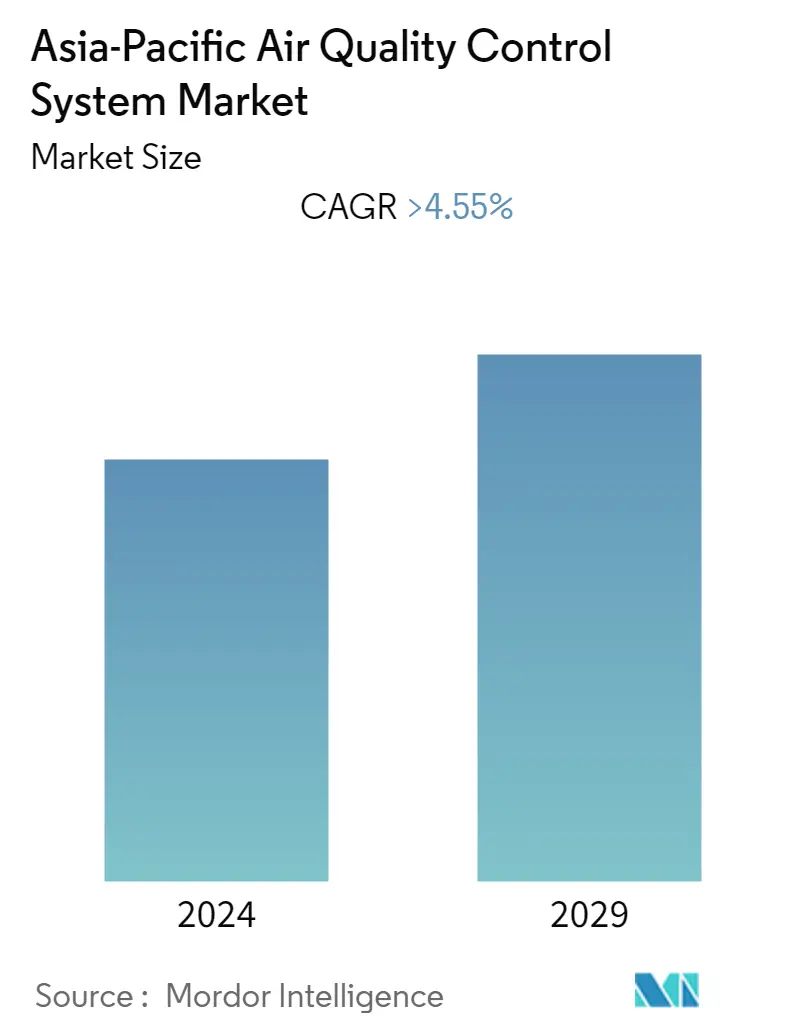
| Study Period | 2020 - 2029 |
| Base Year For Estimation | 2023 |
| Forecast Data Period | 2024 - 2029 |
| Historical Data Period | 2020 - 2022 |
| CAGR | 4.55 % |
Major Players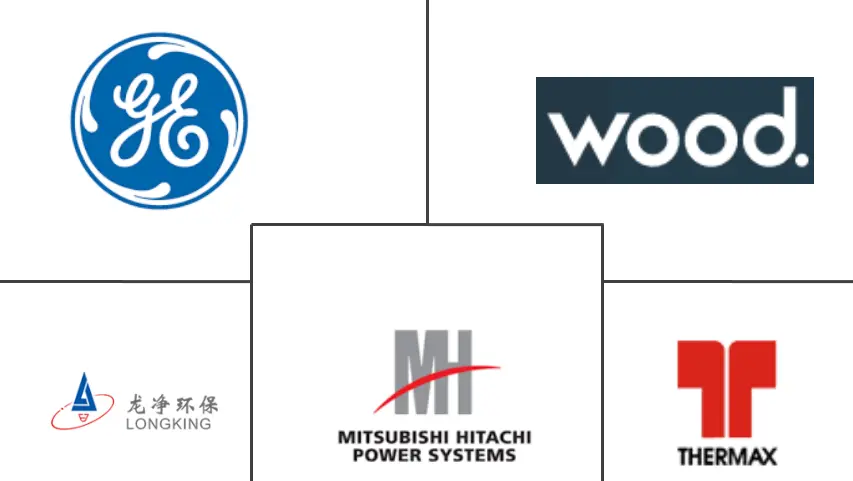
*Disclaimer: Major Players sorted in no particular order |
APAC Air Quality Control System Market Analysis
Asia-Pacific Air Quality Control System Market is projected to register a CAGR of over 4.55% during the forecast period.
COVID-19 negatively impacted the market in 2020. Presently the market is likely to reach pre-pandemic levels.
- Over the medium term, factors, such as the development of industrial infrastructure, coupled with government-led initiatives to curb harmful emissions, are expected to provide impetus to the Asia-Pacific Air Quality Control Systems (AQCS) market.
- On the other hand, the renewable power generation capacity has increased significantly in the last decade, and a similar trend is expected to continue, in turn, increasing the share of renewables in Asia-Pacific power generation during the forecast period, which is likely to restrain the growth of the Asia-Pacific air quality control system in the coming years.
- Nevertheless, the High Efficiency, Low Emission (HELE) coal-fired power plants have been installed in countries such as China and India. This type of power plant requires high-efficiency AQCS to achieve low emissions. This is likely to open new avenues for advanced AQCS-related investments by the end-user industries during the forecast period.
- China is expected to be the significant market for AQCS during the forecast period.
APAC Air Quality Control System Market Trends
This section covers the major market trends shaping the APAC Air Quality Control System Market according to our research experts:
Power Generation Industry Segment to Witness Significant Growth
- Power plants are the largest sources of emission of SO2, mercury, and acid gases. In the power sector, coal accounts for about 98% of SO2 emissions, 94% of mercury emissions, 86% of NOx emissions, and 83% of fine particulate emissions.
- The growing concerns regarding environmental pollution and the government's actions to curb the same are driving the growth of the AQCS market. Stringent international and government regulations, such as the Clean Air Act (CAA) and the Mercury and Air Toxics Standards, enforce the installation of systems that monitor and curb emissions to bring them to a safer level in power generation companies using fossil fuels.
- Further, despite the shrinking number of coal-based power plants globally, the countries (such as India) are still endorsing the new coal-based power generation projects. About 31 GW of power plants is under construction. Due to overcapacity and competition from cheaper renewables, low plant-load factors have made it difficult for coal plants to recover their investments. Despite these unfavorable market conditions for coal-based power, the governments in the region continue to invest in new plants.
- In July 2022, Through its subsidiary, JERA Power Taketoyo G.K., JERA Co., Inc. began commercial operation of Unit 5 of the Taketoyo Thermal Power Station located at 1-1 Ryugu, Taketoyo-Cho, Chita County, Aichi Prefecture, Japan. The company has been replacing aging equipment for the past couple of years. This high-efficiency coal-fired power plant is equipped with Ultra-Supercritical (USC) power generation technology.
- As of 2022, the Quang Trach 1 Coal-fired Power Plant is under construction in Vietnam with a capacity of 1.2 gigawatts, and the estimated plant investment is USD 1.27 billion. The project is expected to be commissioned by 2025 and generate up to 8.4 billion kilowatt-hours of electricity annually.
- Hence, the power industry is expected to witness significant growth for AQCS during the forecast period.
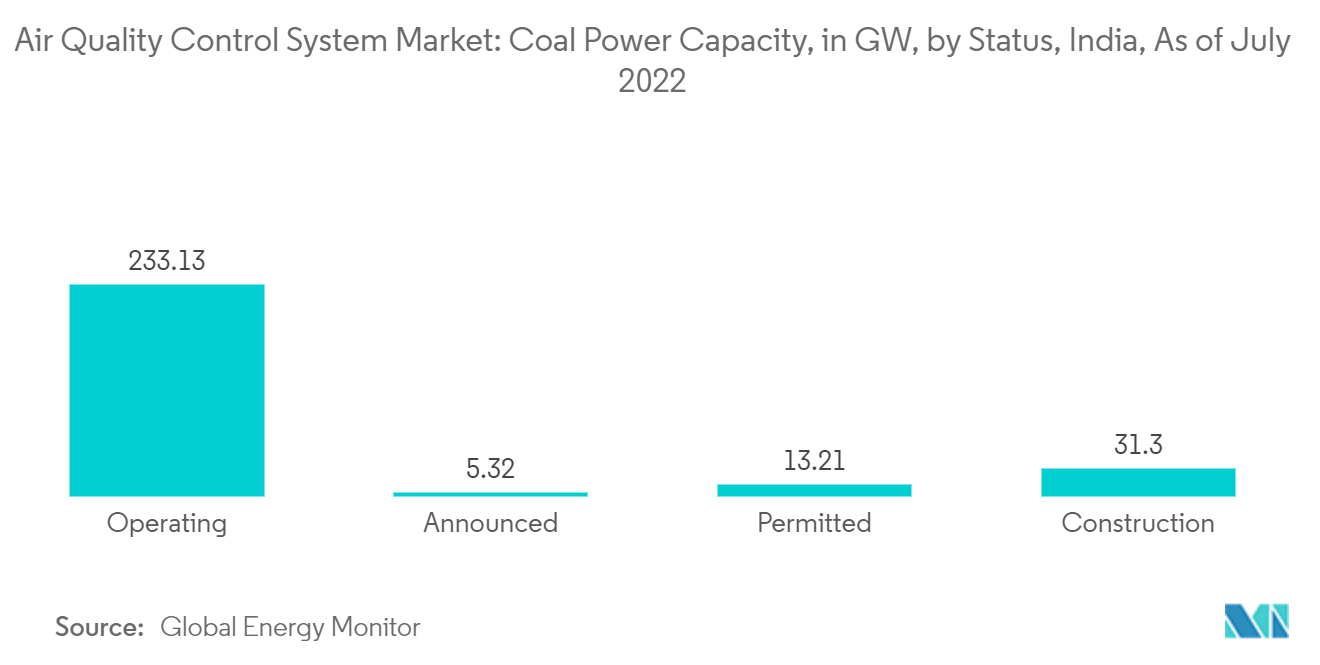
China is Expected to Witness Significant Growth
- The rapid growth in the Chinese economy, particularly the industrial sector, including power generation, cement manufacturing, and chemicals and metal processing, has led to significant growth in the emission of air pollutants in the country.
- Hence, the Government of China has recognized the severity of air pollution due to high energy consumption and the need to control pollution.
- While most countries experienced dramatic reductions in emissions in 2020 due to COVID-19, China was one of only a few countries where emissions increased in 2021. China released 11.47 billion metric tons of carbon dioxide in 2021, making it the world's largest polluter at the time.
- For instance, the State Council of China issued the Air Pollution Prevention and Control Action Plan in September 2013, which sets quantitative targets to improve the air quality in the country within specified time limits.
- In addition, all newly constructed and existing power plants have been subjected to mercury emission standards from 2015. These environmental regulations have further propelled the demand for air quality control systems in the country.
- In May 2022, A new Action Plan on Controlling New Pollutants has been announced by the General Office of the State Council of China. By 2025, the plan intends to screen chemicals of high concern in large quantities for environmental risks, continuously update a list of key regulated new pollutants after releasing the first edition in 2022, and implement environmental risk management measures, such as bans, restrictions, and discharge limits for key regulated new pollutants. Another objective of the project is to develop in phases legal systems and frameworks for managing the environmental risks associated with toxic and hazardous chemicals in order to control new pollutants strictly.
- Hence, factors, such as rising emissions, due to the growth in economic activities and the stringent regulations put forth by the government, have been driving the growth of the air quality control systems market in China.
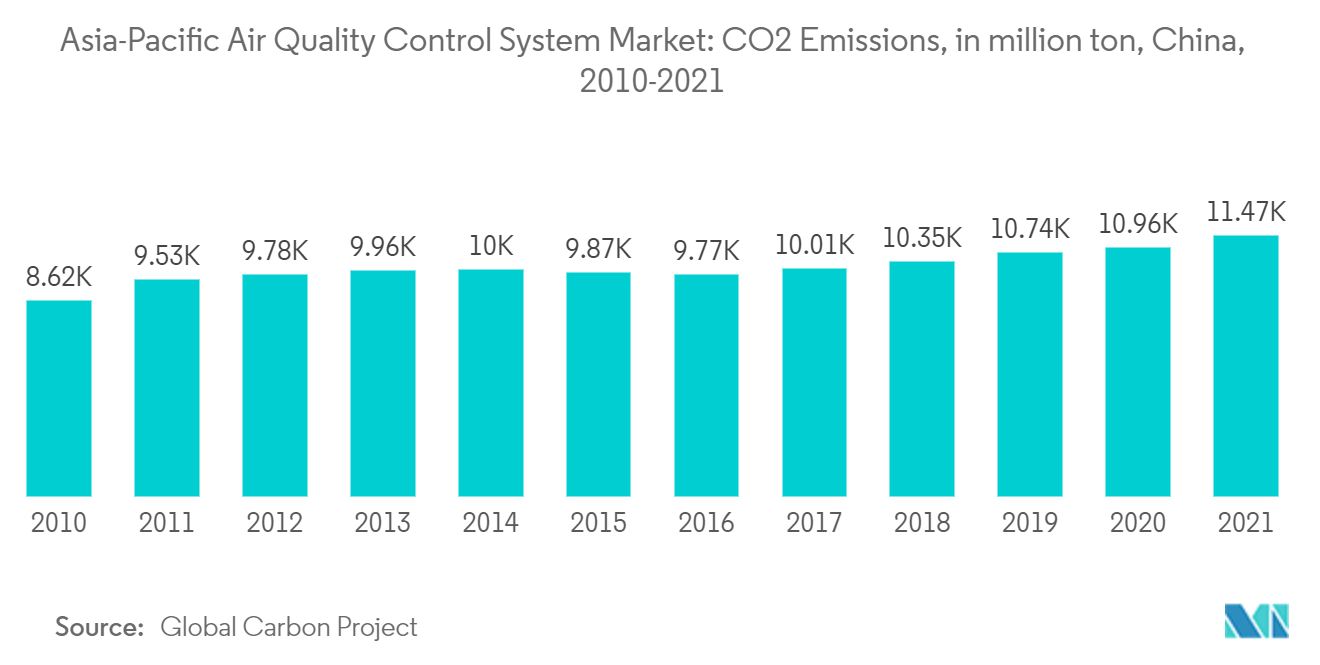
APAC Air Quality Control System Industry Overview
The Asia-Pacific Air Quality Control System Market is fragmented. Some of the key players (not in particular order) in this market include Mitsubishi Hitachi Power Systems Ltd, Thermax Ltd, John Wood Group PLC, General Electric Company, and Fujian Longking Co. Ltd.
APAC Air Quality Control System Market Leaders
-
Mitsubishi Hitachi Power Systems Ltd
-
Thermax Ltd
-
John Wood Group PLC
-
General Electric Company
-
Fujian Longking Co. Ltd
*Disclaimer: Major Players sorted in no particular order
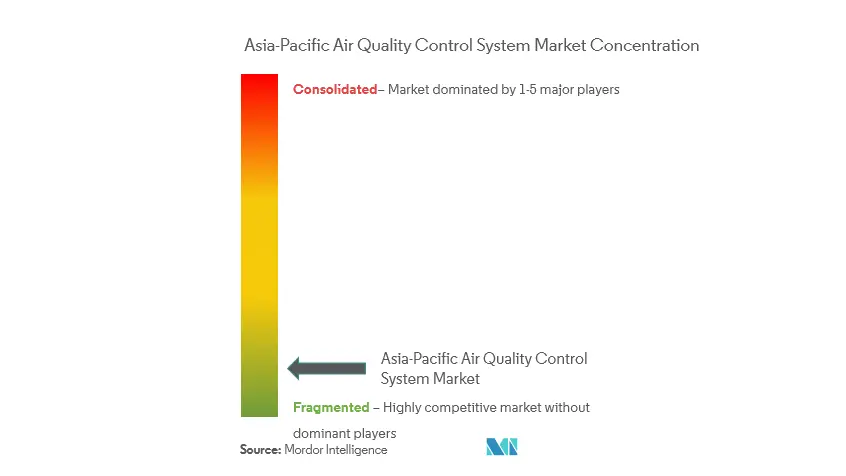
APAC Air Quality Control System Market News
- November 2022: in Delhi-NCR, the Commission for Air Quality Management (CAQM) works in partnership with scientific institutions to prevent, control, and abate air pollution. As a result of thorough technical and financial analysis, the commission has approved seven proposals, including the Autonomous Drone Swarm Framework for real-time air quality monitoring, an AI-based vehicle counting tool, and a Decision Support System (DSS) for the management of air quality in Delhi and surrounding areas.
- September 2022: ADB launched the Asia Clean Blue Skies Program (ACBSP) to increase ADB's investment in improving air quality in Asia and the Pacific. As part of the Fourth Asia Pacific Clean Air Partnership, which was launched in the Republic of Korea, ACBSP will support the preparation and strengthening of policies and plans in Developing Member Countries (DMCs) of the ADB to encourage investments in projects which improve air quality by reducing greenhouse gas emissions in energy, agriculture, transportation, industrial development, and urban development, among other sectors.
APAC Air Quality Control System Market Report - Table of Contents
1. INTRODUCTION
- 1.1 Scope of the Study
- 1.2 Market Definition
- 1.3 Study Assumptions
2. EXECUTIVE SUMMARY
3. RESEARCH METHODOLOGY
4. MARKET OVERVIEW
- 4.1 Introduction
- 4.2 Market Size and Demand Forecast in USD billion, till 2027
- 4.3 Recent Trends and Developments
- 4.4 Government Policies and Regulations
-
4.5 Market Dynamics
- 4.5.1 Drivers
- 4.5.2 Restraints
- 4.6 Supply Chain Analysis
-
4.7 Porter's Five Forces Analysis
- 4.7.1 Bargaining Power of Suppliers
- 4.7.2 Bargaining Power of Consumers
- 4.7.3 Threat of New Entrants
- 4.7.4 Threat of Substitutes Products and Services
- 4.7.5 Intensity of Competitive Rivalry
5. MARKET SEGMENTATION
-
5.1 Application
- 5.1.1 Power Generation Industry
- 5.1.2 Cement Industry
- 5.1.3 Chemical Industry
- 5.1.4 Iron and Steel Industry
- 5.1.5 Other Applications
-
5.2 Type
- 5.2.1 Electrostatic Precipitators (ESP)
- 5.2.2 Flue Gas Desulfurization (FGD) and Scrubbers
- 5.2.3 Selective Catalytic Reduction (SCR)
- 5.2.4 Fabric Filters
- 5.2.5 Other Types
-
5.3 Geography
- 5.3.1 India
- 5.3.2 China
- 5.3.3 Japan
- 5.3.4 Australia
- 5.3.5 Rest of Asia-Pacific
6. COMPETITIVE LANDSCAPE
- 6.1 Mergers and Acquisitions, Joint Ventures, Collaborations, and Agreements
- 6.2 Strategies Adopted by Leading Players
-
6.3 Company Profiles
- 6.3.1 Mitsubishi Hitachi Power Systems Ltd
- 6.3.2 Thermax Ltd
- 6.3.3 John Wood Group PLC
- 6.3.4 Babcock & Wilcox Enterprises Inc.
- 6.3.5 General Electric Company
- 6.3.6 Fujian Longking Co. Ltd
- 6.3.7 Gea Bischoff
- 6.3.8 Hamon Corporation
- 6.3.9 Horiba Ltd
- 6.3.10 Andritz AG
- *List Not Exhaustive
7. MARKET OPPORTUNITIES AND FUTURE TRENDS
** Subject To AvailablityAPAC Air Quality Control System Industry Segmentation
Air Quality Control Systems (AQCS) is a piece of equipment that cleans the flue gases emitted from various industries. The control of air pollution is the process of reducing or eliminating the emissions of pollutants into the atmosphere that may harm the environment or human health. Air pollution control is a major part of pollution control, along with wastewater treatment, solid waste management, and hazardous waste management.
The Asia-Pacific Air Quality Control System Market is segmented by application, type, and geography. By application, the market is segmented into the power generation industry, cement industry, chemical industry, iron and steel industry, and other applications. By type, the market is segmented into Electrostatic Precipitators (ESP), Flue Gas Desulfurization (FGD) and scrubbers, Selective Catalytic Reduction (SCR), fabric filters, and other types. The report also covers the market size and forecasts for the air quality control system market across major countries. The market size and forecasts for each segment have been done regarding revenue (USD billion).
| Application | Power Generation Industry |
| Cement Industry | |
| Chemical Industry | |
| Iron and Steel Industry | |
| Other Applications | |
| Type | Electrostatic Precipitators (ESP) |
| Flue Gas Desulfurization (FGD) and Scrubbers | |
| Selective Catalytic Reduction (SCR) | |
| Fabric Filters | |
| Other Types | |
| Geography | India |
| China | |
| Japan | |
| Australia | |
| Rest of Asia-Pacific |
APAC Air Quality Control System Market Research FAQs
What is the current Asia-Pacific Air Quality Control System Market size?
The Asia-Pacific Air Quality Control System Market is projected to register a CAGR of greater than 4.55% during the forecast period (2024-2029)
Who are the key players in Asia-Pacific Air Quality Control System Market?
Mitsubishi Hitachi Power Systems Ltd, Thermax Ltd, John Wood Group PLC, General Electric Company and Fujian Longking Co. Ltd are the major companies operating in the Asia-Pacific Air Quality Control System Market.
What years does this Asia-Pacific Air Quality Control System Market cover?
The report covers the Asia-Pacific Air Quality Control System Market historical market size for years: 2020, 2021, 2022 and 2023. The report also forecasts the Asia-Pacific Air Quality Control System Market size for years: 2024, 2025, 2026, 2027, 2028 and 2029.
APAC Air Quality Control System Industry Report
Statistics for the 2024 APAC Air Quality Control System market share, size and revenue growth rate, created by Mordor Intelligence™ Industry Reports. APAC Air Quality Control System analysis includes a market forecast outlook to 2029 and historical overview. Get a sample of this industry analysis as a free report PDF download.



